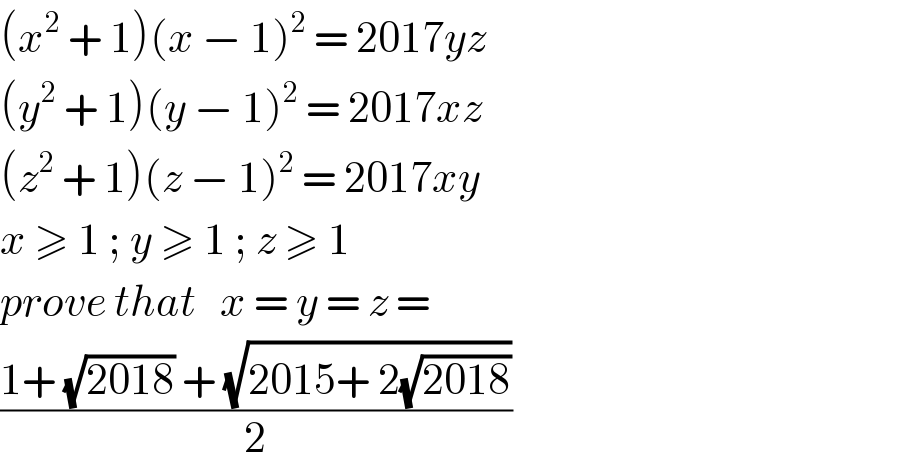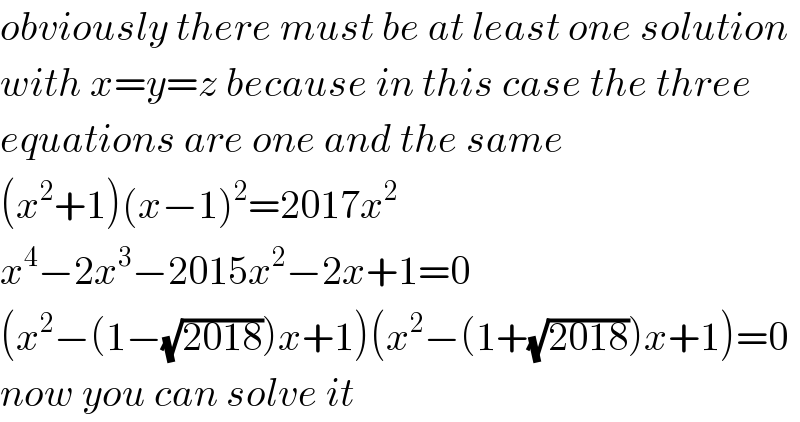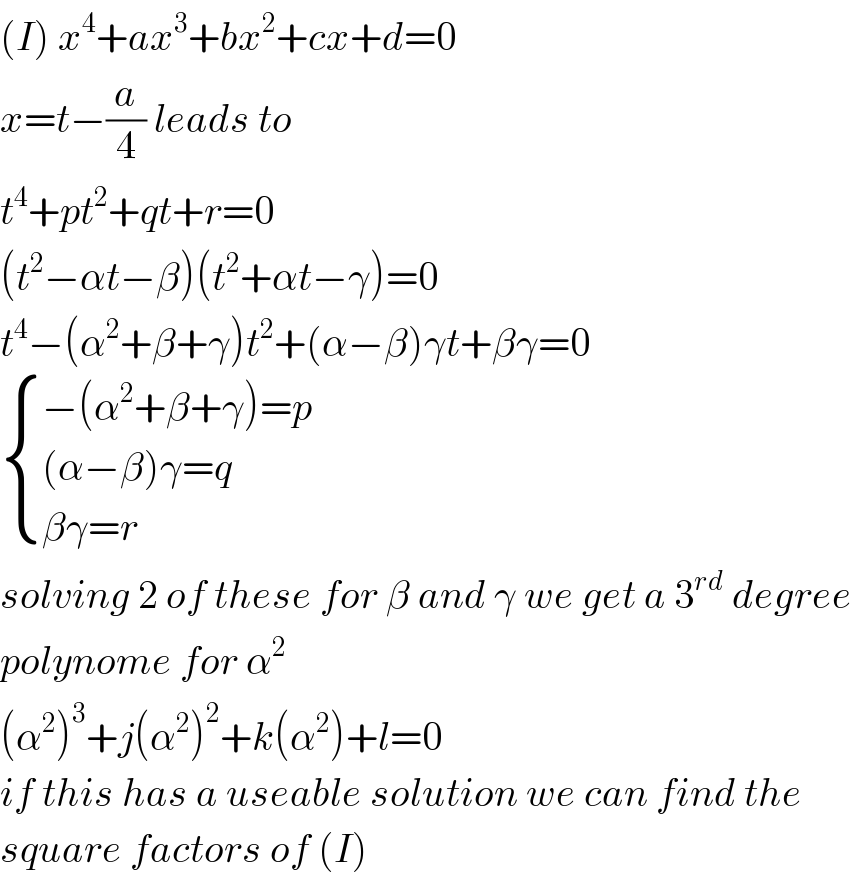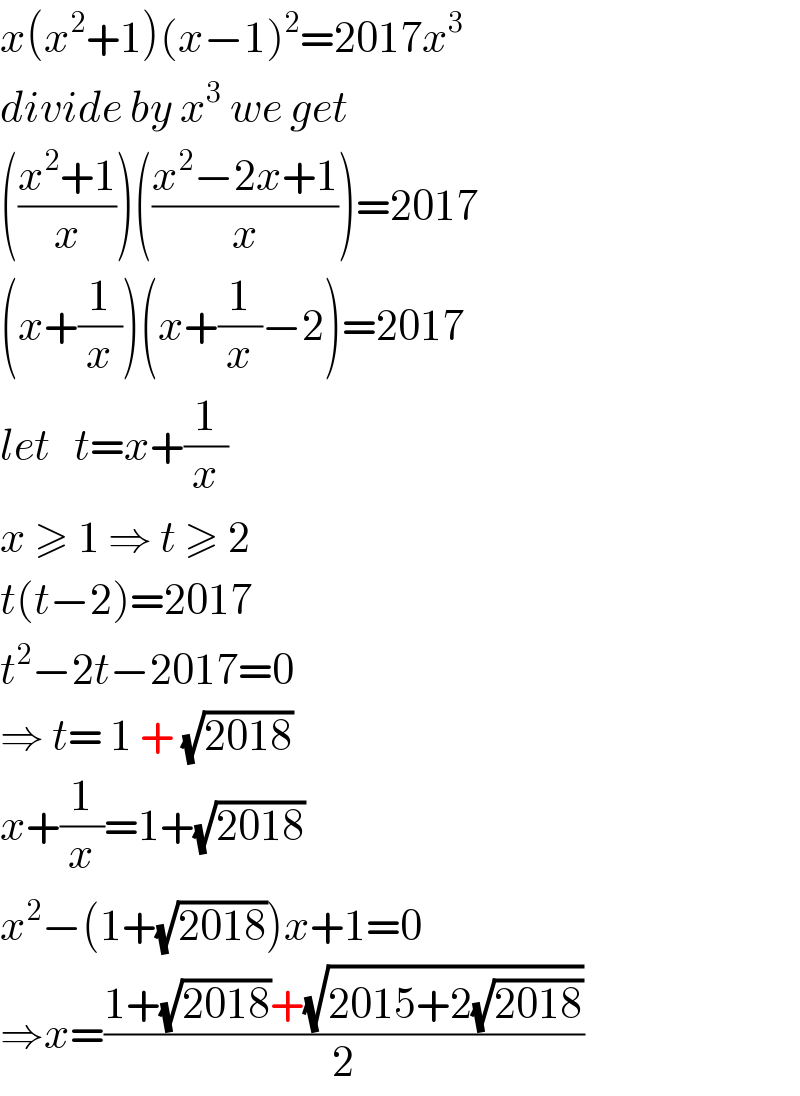Question Number 106233 by malwaan last updated on 03/Aug/20

$$\left({x}^{\mathrm{2}} \:+\:\mathrm{1}\right)\left({x}\:−\:\mathrm{1}\right)^{\mathrm{2}} \:=\:\mathrm{2017}{yz} \\ $$$$\left({y}^{\mathrm{2}} \:+\:\mathrm{1}\right)\left({y}\:−\:\mathrm{1}\right)^{\mathrm{2}} \:=\:\mathrm{2017}{xz} \\ $$$$\left({z}^{\mathrm{2}} \:+\:\mathrm{1}\right)\left({z}\:−\:\mathrm{1}\right)^{\mathrm{2}} \:=\:\mathrm{2017}{xy} \\ $$$${x}\:\geqslant\:\mathrm{1}\:;\:{y}\:\geqslant\:\mathrm{1}\:;\:{z}\:\geqslant\:\mathrm{1} \\ $$$${prove}\:{that}\:\:\:{x}\:=\:{y}\:=\:{z}\:= \\ $$$$\frac{\mathrm{1}+\:\sqrt{\mathrm{2018}}\:+\:\sqrt{\mathrm{2015}+\:\mathrm{2}\sqrt{\mathrm{2018}}}}{\mathrm{2}} \\ $$
Answered by Her_Majesty last updated on 04/Aug/20

$${obviously}\:{there}\:{must}\:{be}\:{at}\:{least}\:{one}\:{solution} \\ $$$${with}\:{x}={y}={z}\:{because}\:{in}\:{this}\:{case}\:{the}\:{three} \\ $$$${equations}\:{are}\:{one}\:{and}\:{the}\:{same} \\ $$$$\left({x}^{\mathrm{2}} +\mathrm{1}\right)\left({x}−\mathrm{1}\right)^{\mathrm{2}} =\mathrm{2017}{x}^{\mathrm{2}} \\ $$$${x}^{\mathrm{4}} −\mathrm{2}{x}^{\mathrm{3}} −\mathrm{2015}{x}^{\mathrm{2}} −\mathrm{2}{x}+\mathrm{1}=\mathrm{0} \\ $$$$\left({x}^{\mathrm{2}} −\left(\mathrm{1}−\sqrt{\mathrm{2018}}\right){x}+\mathrm{1}\right)\left({x}^{\mathrm{2}} −\left(\mathrm{1}+\sqrt{\mathrm{2018}}\right){x}+\mathrm{1}\right)=\mathrm{0} \\ $$$${now}\:{you}\:{can}\:{solve}\:{it} \\ $$
Commented by Sarah85 last updated on 04/Aug/20
you learn fast it seems
Commented by Her_Majesty last updated on 04/Aug/20

$${I}\:{forgot}\:{more}\:{than}\:{you}'{ll}\:{ever}\:{know}… \\ $$
Commented by malwaan last updated on 04/Aug/20

$${thank}\:{you} \\ $$$${but}\:{how}\:{you}\:{factor}\:\:{the}\:{quartic}\: \\ $$$${equation}\:{which}\:{has}\:\mathrm{4}\:{solutions} \\ $$$${only}\:{one}\:{is}\:{correct}\:? \\ $$
Commented by Her_Majesty last updated on 04/Aug/20

$$\left({I}\right)\:{x}^{\mathrm{4}} +{ax}^{\mathrm{3}} +{bx}^{\mathrm{2}} +{cx}+{d}=\mathrm{0} \\ $$$${x}={t}−\frac{{a}}{\mathrm{4}}\:{leads}\:{to} \\ $$$${t}^{\mathrm{4}} +{pt}^{\mathrm{2}} +{qt}+{r}=\mathrm{0} \\ $$$$\left({t}^{\mathrm{2}} −\alpha{t}−\beta\right)\left({t}^{\mathrm{2}} +\alpha{t}−\gamma\right)=\mathrm{0} \\ $$$${t}^{\mathrm{4}} −\left(\alpha^{\mathrm{2}} +\beta+\gamma\right){t}^{\mathrm{2}} +\left(\alpha−\beta\right)\gamma{t}+\beta\gamma=\mathrm{0} \\ $$$$\begin{cases}{−\left(\alpha^{\mathrm{2}} +\beta+\gamma\right)={p}}\\{\left(\alpha−\beta\right)\gamma={q}}\\{\beta\gamma={r}}\end{cases} \\ $$$${solving}\:\mathrm{2}\:{of}\:{these}\:{for}\:\beta\:{and}\:\gamma\:{we}\:{get}\:{a}\:\mathrm{3}^{{rd}} \:{degree} \\ $$$${polynome}\:{for}\:\alpha^{\mathrm{2}} \\ $$$$\left(\alpha^{\mathrm{2}} \right)^{\mathrm{3}} +{j}\left(\alpha^{\mathrm{2}} \right)^{\mathrm{2}} +{k}\left(\alpha^{\mathrm{2}} \right)+{l}=\mathrm{0} \\ $$$${if}\:{this}\:{has}\:{a}\:{useable}\:{solution}\:{we}\:{can}\:{find}\:{the} \\ $$$${square}\:{factors}\:{of}\:\left({I}\right) \\ $$
Commented by malwaan last updated on 05/Aug/20

$${I}\:{used}\:{another}\:{method} \\ $$$${long}\:{but}\:{easy} \\ $$
Answered by malwaan last updated on 05/Aug/20

$${x}\left({x}^{\mathrm{2}} +\mathrm{1}\right)\left({x}−\mathrm{1}\right)^{\mathrm{2}} =\mathrm{2017}{x}^{\mathrm{3}} \\ $$$${divide}\:{by}\:{x}^{\mathrm{3}} \:{we}\:{get} \\ $$$$\left(\frac{{x}^{\mathrm{2}} +\mathrm{1}}{{x}}\right)\left(\frac{{x}^{\mathrm{2}} −\mathrm{2}{x}+\mathrm{1}}{{x}}\right)=\mathrm{2017} \\ $$$$\left({x}+\frac{\mathrm{1}}{{x}}\right)\left({x}+\frac{\mathrm{1}}{{x}}−\mathrm{2}\right)=\mathrm{2017} \\ $$$${let}\:\:\:{t}={x}+\frac{\mathrm{1}}{{x}} \\ $$$${x}\:\geqslant\:\mathrm{1}\:\Rightarrow\:{t}\:\geqslant\:\mathrm{2} \\ $$$${t}\left({t}−\mathrm{2}\right)=\mathrm{2017} \\ $$$${t}^{\mathrm{2}} −\mathrm{2}{t}−\mathrm{2017}=\mathrm{0} \\ $$$$\Rightarrow\:{t}=\:\mathrm{1}\:+\:\sqrt{\mathrm{2018}} \\ $$$${x}+\frac{\mathrm{1}}{{x}}=\mathrm{1}+\sqrt{\mathrm{2018}} \\ $$$${x}^{\mathrm{2}} −\left(\mathrm{1}+\sqrt{\mathrm{2018}}\right){x}+\mathrm{1}=\mathrm{0} \\ $$$$\Rightarrow{x}=\frac{\mathrm{1}+\sqrt{\mathrm{2018}}+\sqrt{\mathrm{2015}+\mathrm{2}\sqrt{\mathrm{2018}}}}{\mathrm{2}} \\ $$
Commented by Her_Majesty last updated on 05/Aug/20

$${good}! \\ $$
